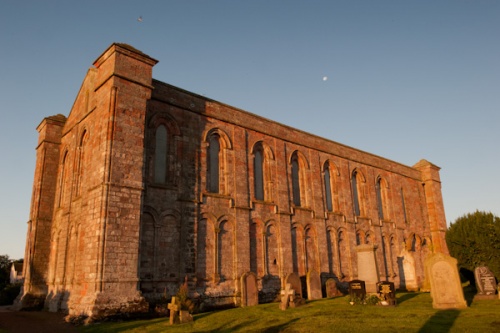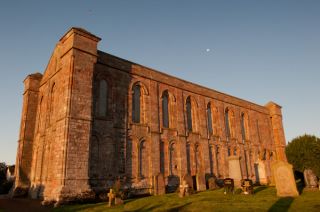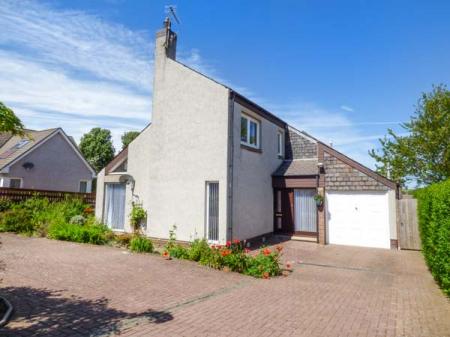
But why did the monks of Durham choose this site?
For the answer, we have to go back in time a further 400 years, to around 640 AD, when a Northumbrian princess named Ebba (Aebba) established a dual monastery (for both men and women) at Kirk Hill, St Abbs Head. The monastery was destroyed by fire in 683 and the monks and nuns decided to rebuild in a more sheltered location. They chose Coldingham, further inland from the coast.
The medieval priory very quickly grew in size and importance and became the hub of a far-reaching network of estates and trading ventures that extended into Europe. Coldingham grew to become the second wealthiest monastery in Scotland, behind only to Holyrood Abbey in Edinburgh.
Unfortunately for the monks of Coldingham, much of that wealth went to their mother church at Durham. At the height of its prosperity, Coldingham had some 30 monks supported by a further 70 lay workers.

Around 1200 a group of monks at Coldingham compiled a 'Life of Ebba', drawing together various legends about St Aebba. One of the aims of the book was to encourage pilgrimages to the site of Aebba's monastery and holy well, and, by no coincidence, to Coldingham Priory itself.
In 1216 King John of England raided Coldingham as part of his efforts to prevent an alliance between his rebellious barons and their Scottish counterparts. The Priory was rebuilt under the Prior, Thomas de Melsonby, but suffered a gradual decline, which was only accelerated by the Black Death of 1348-50. The interminable Border conflicts that ravaged the Borders area left their toll, as did the religious Reformation of the 16th century.
One infamous episode in Coldingham's history came in 1420 when a group of Border reivers barricaded themselves in the church. The prior, William Drax, smoked them out (some reports say he burned them alive). His actions were condemned by the King and Parliament, whereupon Drax fled to Durham, taking with him the priory charters. Drax eventually returned to Coldingham, but the charters were left in Durham, where they remain to this day.
In 1472 James III convinced the Pope to suppress Coldingham Priory so that it became a collegiate church. This meant that the king could then have easier access to the church funds. James also built a chapel, called the 'Chapel of the King of Scots'.
Another violent episode occurred in 1519 when Prior Robert Blackadder was murdered by David Home of Wedderburn, who promptly married the Prior's widow. His younger brothers then married the Prior's two daughters.
With the changes in Scottish religious life following the Reformation, the title Prior of Coldingham became a purely temporal title, in the hands of the Home (Hume) family. Finally, in 1606 the sixth Lord Home gave up the title for good.
The final blow for Coldingham Priory came in 1648 when a group of Royalist sympathizers took shelter in the church with their store of gunpowder. Oliver Cromwell besieged the site, bombarding it with guns mounted atop Coldingham Law, and the medieval buildings were largely destroyed. In 1662 the local laird rebuilt the choir and added a bell tower, but this collapsed a century later.

For two centuries the ruins decayed until the church was rebuilt during the Victorian period to serve as the parish church for Coldingham. The new Victorian building incorporated bits of the medieval priory church, particularly at the east end and the north wall of the choir.
Extensive remains of medieval buildings still stand to the south of the church. Here you will find foundation walls of the cloisters, refectory, and chapter house. The most obvious remain, however, is a large freestanding archway, which originally stood between the south aisle and the south transept. This is probably a Victorian reconstruction of the original arch, but it does stand on the original foundations.
Beside the archway is a wonderful lapidarium - a collection of carved masonry and gravestones. Gathered in this corner of the churchyard is a wonderfully diverse array of carved stones, ranging from grotesque heads to Templar grave slabs. Some are medieval, like a grinning Green Man, and some post-date the priory, like an 18th-century shepherd's gravestone. There are piscinas and quern stones, and a wonderful gravestone for a mason, showing the tools of his trade. At the entrance to the site is a Victorian mortuary and hearse-house.
Coldingham Priory is a wonderfully evocative site. There are extremely useful information signs throughout, which do a great job of explaining the history of the priory.
NB. Though the ruins of the priory can be explored at any time, the church itself, incorporating parts of the medieval structure, is only open at specified times (see notice board outside the church).












 We've 'tagged' this attraction information to help you find related historic attractions and learn more about major time periods mentioned.
We've 'tagged' this attraction information to help you find related historic attractions and learn more about major time periods mentioned.


